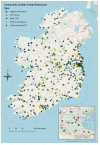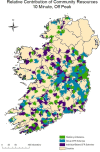Mapping the potential of community first responders to increase cardiac arrest survival
- PMID: 30402259
- PMCID: PMC6203054
- DOI: 10.1136/openhrt-2018-000912
Mapping the potential of community first responders to increase cardiac arrest survival
Abstract
Objective: Resuscitation from out-of-hospital cardiac arrest (OHCA) is largely determined by the availability of cardiopulmonary resuscitation (CPR) and defibrillation within 5-10 min of collapse. The potential contribution of organised groups of volunteers to delivery of CPR and defibrillation in their communities has been little studied. Ireland has extensive networks of such volunteers; this study develops and tests a model to examine the potential impact at national level of these networks on early delivery of care.
Methods: A geographical information systems study considering all statutory ambulance resource locations and all centre point locations for community first responder (CFR) schemes that operate in Ireland were undertaken. ESRI ArcGIS Desktop 10.4 was used to map CFR and ambulance base locations. ArcGIS Online proximity analysis function was used to model 5-10 min drive time response areas under sample peak and off-peak conditions. Response areas were linked to Irish population census data so as to establish the proportion of the population that have the potential to receive a timely cardiac arrest emergency response.
Results: This study found that CFRs are present in many communities throughout Ireland and have the potential to reach a million additional citizens before the ambulance service and within a timeframe where CPR and defibrillation are likely to be effective treatments.
Conclusion: CFRs have significant potential to contribute to survival following OHCA in Ireland. Further research that examines the processes, experiences and outcomes of CFR involvement in OHCA resuscitation should be a scientific priority.
Keywords: community health planning; emergency first responders; geographic information systems; out-of-hospital cardiac arrest; ventricular fibrillation.
Conflict of interest statement
Competing interests: None declared.
Figures



Similar articles
-
Community first responders for out-of-hospital cardiac arrest in adults and children.Cochrane Database Syst Rev. 2019 Jul 19;7(7):CD012764. doi: 10.1002/14651858.CD012764.pub2. Cochrane Database Syst Rev. 2019. PMID: 31323120 Free PMC article.
-
Use of automated external defibrillators in cardiac arrest: an evidence-based analysis.Ont Health Technol Assess Ser. 2005;5(19):1-29. Epub 2005 Dec 1. Ont Health Technol Assess Ser. 2005. PMID: 23074470 Free PMC article.
-
Out-of-hospital cardiac arrest surveillance --- Cardiac Arrest Registry to Enhance Survival (CARES), United States, October 1, 2005--December 31, 2010.MMWR Surveill Summ. 2011 Jul 29;60(8):1-19. MMWR Surveill Summ. 2011. PMID: 21796098
-
Urban and rural differences in out-of-hospital cardiac arrest in Ireland.Resuscitation. 2015 Jun;91:42-7. doi: 10.1016/j.resuscitation.2015.03.012. Epub 2015 Mar 26. Resuscitation. 2015. PMID: 25818707
-
Out of hospital cardiac arrest: Past, present, and future.Resuscitation. 2021 Aug;165:101-109. doi: 10.1016/j.resuscitation.2021.06.010. Epub 2021 Jun 21. Resuscitation. 2021. PMID: 34166740 Review.
Cited by
-
Motivation, challenges and realities of volunteer community cardiac arrest response: a qualitative study of 'lay' community first responders.BMJ Open. 2019 Aug 8;9(8):e029015. doi: 10.1136/bmjopen-2019-029015. BMJ Open. 2019. PMID: 31399458 Free PMC article.
-
"It's like a swan, all nice and serene on top, and paddling like hell underneath": community first responders' practices in attending patients and contributions to rapid emergency response in rural England, United Kingdom-a qualitative interview study.Scand J Trauma Resusc Emerg Med. 2023 Feb 13;31(1):7. doi: 10.1186/s13049-023-01071-3. Scand J Trauma Resusc Emerg Med. 2023. PMID: 36782273 Free PMC article.
-
Resuscitation for out-of-hospital cardiac arrest in Ireland 2012-2020: Modelling national temporal developments and survival predictors.Resusc Plus. 2024 Apr 18;18:100641. doi: 10.1016/j.resplu.2024.100641. eCollection 2024 Jun. Resusc Plus. 2024. PMID: 38646094 Free PMC article.
-
Exploring national and international experiences with community first responder models: protocol for a scoping review.BMJ Open. 2024 Aug 30;14(8):e085071. doi: 10.1136/bmjopen-2024-085071. BMJ Open. 2024. PMID: 39214657 Free PMC article.
-
Addressing Challenges of Implementing Community First Responder Models based on National and International Experiences: A Systematic Scoping Review.Iran J Public Health. 2024 Dec;53(12):2659-2670. Iran J Public Health. 2024. PMID: 39759193 Free PMC article.
References
-
- CSO Census 2016 summary results - part 1. Dublin: Central Statistics Office, 2017.
-
- OHCAR Out of hospital cardiac arrest register, annual report 2016. Galway: OHCAR, 2017.
LinkOut - more resources
Full Text Sources
